Beelink GTR7 mini-PC Review: A Complete AMD Phoenix Package at 65W
by Ganesh T S on August 24, 2023 8:00 AM ESTGPU Performance: Synthetic Benchmarks
AMD's Phoenix SoCs include an integrated GPU with a microarchitectural update over the one in the Rembrandt-R SoCs. The new RDNA3 microarchitecture is present in the Ryzen 7 7840HS in the form of the Radeon 780M. With 12 CUs and 768 shader units clocked at 2.7 GHz, AMD claims that the GPU should be capable of playing virtually any modern game at Full HD resolutions.
For full-blown desktop systems or mini-PCs targeting the gaming market, we look at gaming workloads. However, for general-purpose mini-PC models like the GEEKOM AS 6, we restrict ourselves to a series of canned benchmarks from Kishonti and Futuremark / UL. Prior to that, a look at the capabilities of the GPU via GPU-Z is warranted.
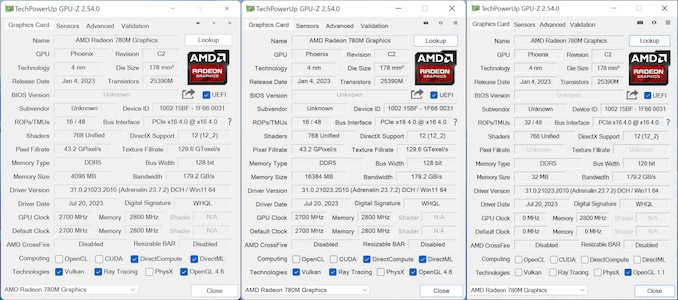
(From L to R: Default BIOS Settings, UMA Buffer Size set to 16G, UMA Buffer Size set to Auto)
Rembrandt-R's Radeon 680M had already achieved an industry-first by integrating hardware-accelerated ray tracing, and the Radeon 780M in Phoenix builds upon that. There are some improvements in the media engine too (such as AV1 encode support), but those are not revealed in the GPU-Z screenshot. The remaining subsections below look into the performance aspects.
GFXBench
The DirectX 12-based GFXBench tests from Kishonti are cross-platform, and available all the way down to smartphones. As such, they are not very taxing for discrete GPUs and modern integrated GPUs. We processed the offscreen versions of the 'Aztec Ruins' benchmark.
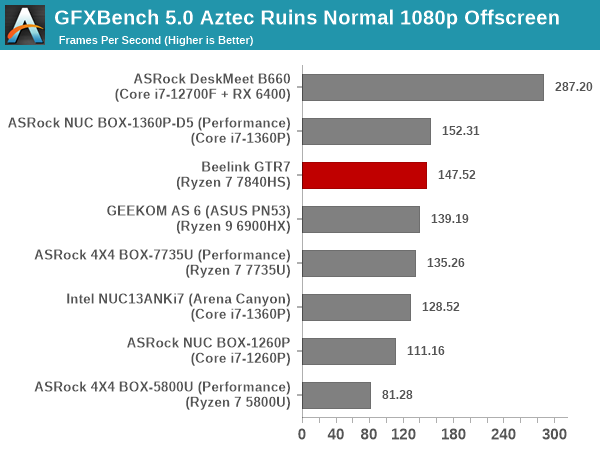
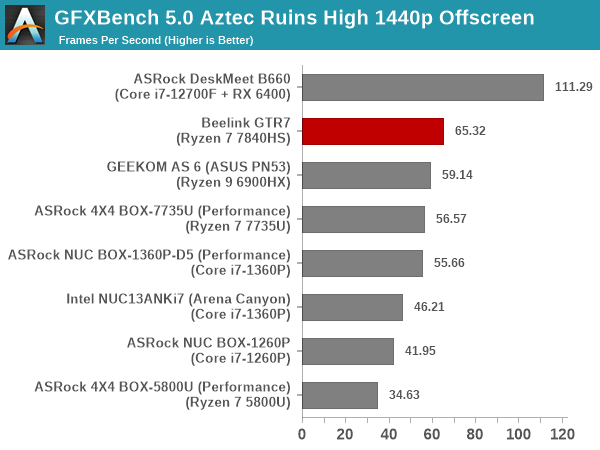
At 1080p, the souped-up ASRock Industrial Raptor Lake-P NUC has a slight edge of around 3% in the frame rate, but the AMD-based systems take back the crown at 1440p. The GTR7 has a 7% edge over the GEEKOM AS 6, which by itself has a 6% edge over the top RPL-P system.
UL 3DMark
Four different workload sets were processed in 3DMark - Fire Strike, Time Spy, Night Raid, and Wild Life.
3DMark Fire Strike
The Fire Strike benchmark has three workloads. The base version is meant for high-performance gaming PCs. It uses DirectX 11 (feature level 11) to render frames at 1920 x 1080. The Extreme version targets 1440p gaming requirements, while the Ultra version targets 4K gaming system, and renders at 3840 x 2160. The graph below presents the overall score for the Fire Strike Extreme and Fire Strike Ultra benchmark across all the systems that are being compared.
| UL 3DMark - Fire Strike Workloads | |||
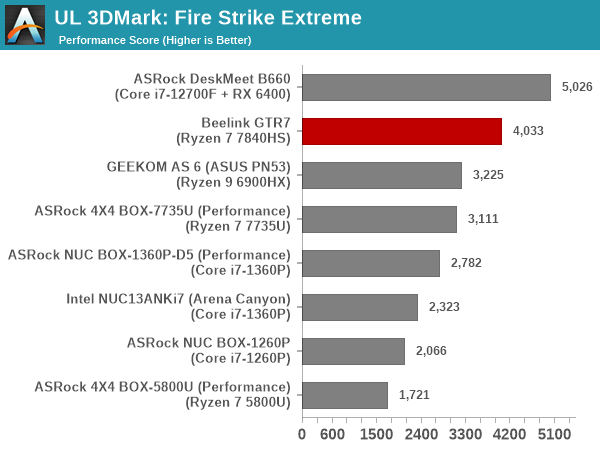
Rembrandt-R already had an edge over RPL-P in these workloads, and Phoenix only cements this position further. The GTR7 shows a 25 - 30% improvement over the GEEKOM AS 6 behind it - a result of the microarchitectural improvements as well as higher power budget.
3DMark Time Spy
The Time Spy workload has two levels with different complexities. Both use DirectX 12 (feature level 11). However, the plain version targets high-performance gaming PCs with a 2560 x 1440 render resolution, while the Extreme version renders at 3840 x 2160 resolution. The graphs below present both numbers for all the systems that are being compared in this review.
| UL 3DMark - Time Spy Workloads | |||
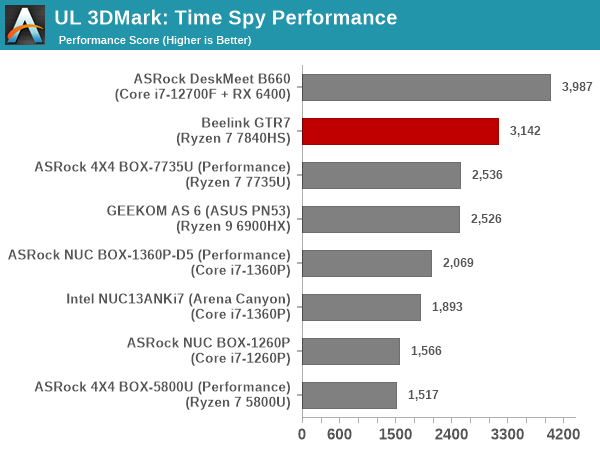
The observations made in Fire Strike workloads hold true for Time Spy also. The advantage for GTR7 over the 42W Ryzen 7 7735U in the ASRock Industrial 4X4 BOX-7735U is around 25%.
3DMark Wild Life
The Wild Life workload was initially introduced as a cross-platform GPU benchmark in 2020. It renders at a 2560 x 1440 resolution using Vulkan 1.1 APIs on Windows. It is a relatively short-running test, reflective of mobile GPU usage. In mid-2021, UL released the Wild Life Extreme workload that was a more demanding version that renders at 3840 x 2160 and runs for a much longer duration reflective of typical desktop gaming usage.
| UL 3DMark - Wild Life Workloads | |||
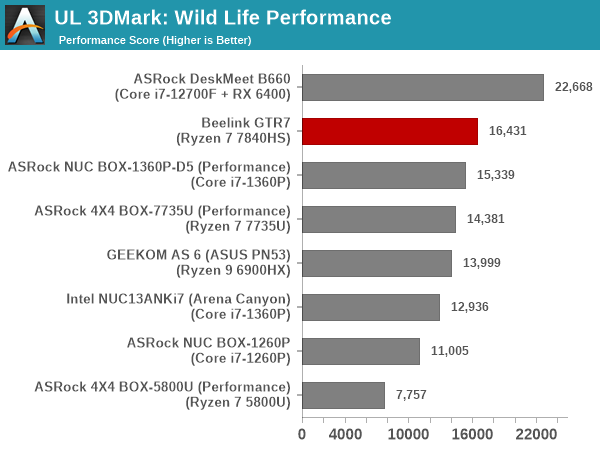
3D Mark Wild Life was one of the GPU workloads where RPL-P's iGPU had performed better than the Radeon 680M in the Rembrandt-R systems. The GTR7's Radeon 780M wrests the crown from the ASRock Industrial NUC BOX-1360P/D5, showing a 7% increase in performance at 1440p and 17% increase at 2160p. This is doubtless due to the improved microarchitecture and higher power budget.
3DMark Night Raid
The Night Raid workload is a DirectX 12 benchmark test. It is less demanding than Time Spy, and is optimized for integrated graphics. The graph below presents the overall score in this workload for different system configurations.
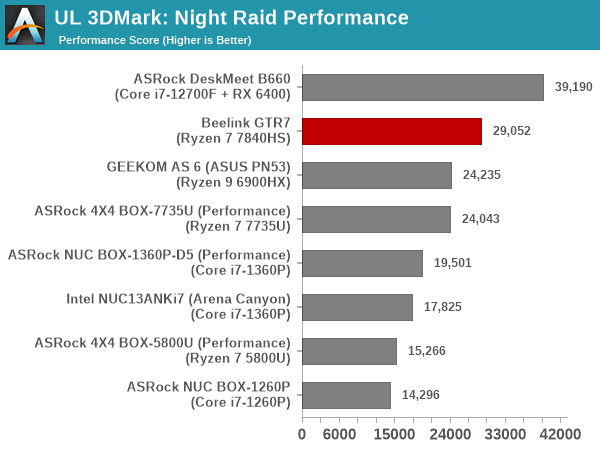
The GTR7 is comfortable on top when systems with iGPUs are considered, with a 20% advantage over the GEEKOM AS 6 (which has a 20% advantage over the best that RPL-P has to offer).
3DMark Port Royal
UL introduced the Port Royal ray-tracing benchmark as a DLC for 3DMark in early 2019. The scores serve as an indicator of how the system handles ray-tracing effects in real-time.
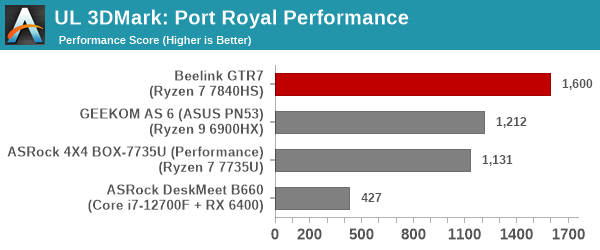
The GTR7 has a 30%+ advantage over the GEEKOM AS 6, thanks to improvements in the ray tracing engine, as well as faster iGPU clocks.


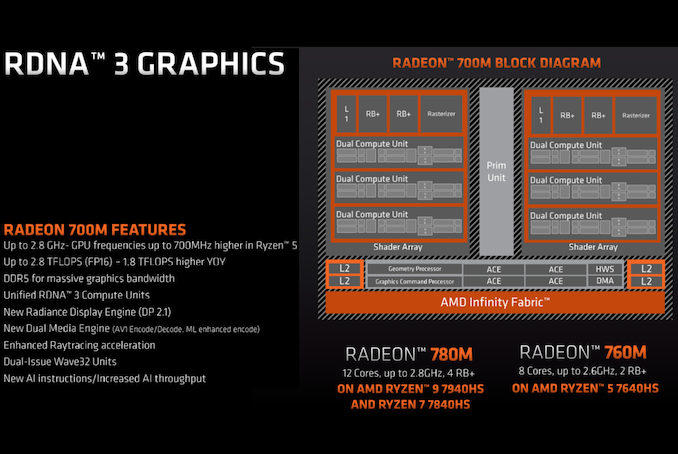








56 Comments
View All Comments
ActionJ26 - Friday, August 25, 2023 - link
Go with Minisforum um790 it is $519 barebonedhaplo602 - Monday, August 28, 2023 - link
that and tested as a SteamOS platform as well ...29a - Thursday, August 24, 2023 - link
"One of the interesting aspects of the I/O ports is the presence of an audio jack in both front and rear panels. Beelink has designed this in such a way that the connection of a headset of speakers to the rear jack automatically disables the front one."Does that mean you cant output different audio streams to both, for example game audio through the speakers in the back and chat audio through headphones on the front. Most MB allow this.
ganeshts - Thursday, August 24, 2023 - link
Can you give me some MB examples that allow this? I want to check their hardware audio path.As per Beelink's user manual, the disabling of the front jack is the expected behavior when the rear jack has a connected sink.
UserZ - Thursday, August 24, 2023 - link
Disabling the front jack seems really odd. I would have a pair of speakers connected to the rear jack as the default audio. When I occasionally plug in a headset to the front, I want to use that. I would hope that you could still choose which to use without unplugging anything in case I don't like their default behavior.darkswordsman17 - Friday, August 25, 2023 - link
Yeah I think it'd be preferable for the inverse (i.e. mute the rear when the front is detected), or for it to be able to be configured so it could do mic input from one with audio output from the other. Its probably easier for them to do this though. But then there's options if you use an external audio via USB (or probably Bluetooth as well).darkswordsman17 - Friday, August 25, 2023 - link
PC motherboards use separate audio chips for front and rear ports generally, and thus its easy for Windows/games to then be configured to output different for each one. I think there might be some external gaming audio boxes that could allow this as well (headset plugged in managing just chat whilst outputting game audio to speakers), so it could come down to drivers (or maybe it auto-configures).1_rick - Thursday, August 24, 2023 - link
The Crucial isn't a bad SSD if your needs align with it's capabilities. One place it completely falls down is large writes: I copied a ~60GB game to a Beelink SEI12 from a USB-C connected SSD, rather than let it be downloaded, and the pSLC cache was exhausted pretty quickly. At that point the performance tanked to somewhere around 40MBps, down about 90% from peak speed of about 500MBps.For normal day-to-day usage, you probably won't see much of a speed penalty, though.
NextGen_Gamer - Thursday, August 24, 2023 - link
@AnandTech: Were the 3DMark Port Royal benchmarks rerun on all of the older systems? Because the DeskMeet B660 system seems way off. The Radeon RX 6400 and Radeon 680M iGPU are actually the same in specs: RDNA-2, 12 Ray Accelerators, 32 ROPs, 48 TMUs, 768 Shading Units. It should, in theory, be RX 6400 just ahead of Ryzen 9 6900HX which in turn should be just ahead of Ryzen 7 7735U. And then the latest Ryzen 7 7840HUS, with its newer and higher-clocked RDNA-3 Radeon 780M iGPU, should be on top of the charts still.ganeshts - Thursday, August 24, 2023 - link
Unlike CPU or GPU reviews, for mini-PCs, we do not update the results in every review because most of the mini-PCs are loaner samples and go back to the manufacturer.The numbers presented in the graph for the Deskmeet B660 are from January 2023, using Adrenalin GPU drivers that were the latest in December 2022. FWIW, 3DMark also has online score submissions from different users searchable at www.3dmark.com/search
For RX 6400, Port Royal overall scores range from 126 to 558 (seems to depend on the CPU also), with an average of 252
For 680M, they range from 1081 to 1415 with an average of 1026.
In the above context, the scores we have graphed (427 and 1212) are entirely plausible.
It is also possible that recent driver releases might have improved scores, but our policy for mini-PC reviews is that we carry forward the scores from the time of the original review. Every few years, we purge the database and move to the latest versions of the benchmarks and also update the OS to the latest stable (for example, we are currently using Win 11 21H2 with the latest updates, but not 22H2). At that time, we choose a set of PCs that we still have in hand, re-bench them and use the newly obtained scores with the new benchmark version / OS for comparisons starting from that point onwards.